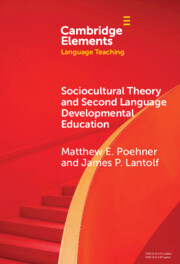Element contents
Sociocultural Theory and Second Language Developmental Education
Published online by Cambridge University Press: 21 May 2024
Summary
Keywords
Information
- Type
- Element
- Information
- Series: Elements in Language TeachingOnline ISBN: 9781009189422Publisher: Cambridge University PressPrint publication: 06 June 2024
References
Accessibility standard: Unknown
Why this information is here
This section outlines the accessibility features of this content - including support for screen readers, full keyboard navigation and high-contrast display options. This may not be relevant for you.Accessibility Information
- 22
- Cited by
